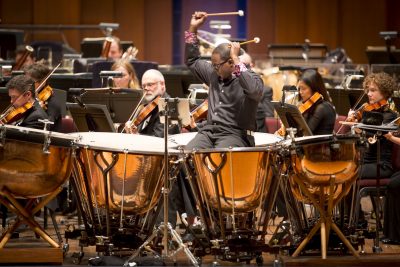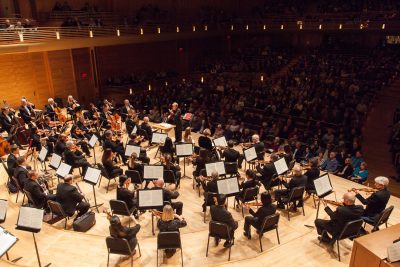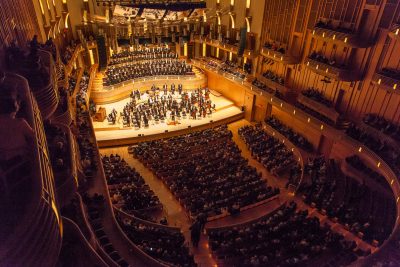Jauvon Gilliam and James Wyman are important players in the small world of symphonic music. Gilliam is principal timpanist for the National Symphony Orchestra (NSO), while Wyman holds the same position at Baltimore Symphony Orchestra (BSO). They have met at auditions and over a beer to exchange notes and talk about their families, but the longtime friends haven’t played together until now. On the afternoon of Jan. 14, they take the Music Center at Strathmore stage to conquer a dozen drums in Philip Glass’ “Concerto Fantasy for Two Timpanists and Orchestra.” A Baltimore native, Glass observes his 80th birthday in 2018, and the BSO kicks off a yearlong celebration of the eminent composer by performing one of his more unusual works.

The popular concerto is a “crowd pleaser,” Gilliam confessed. “There’s a lot of movement around the drums . . . Our sounds will blend together really nicely.”
Traditionally, the timpani, or kettledrum, is a support instrument for the rest of the orchestra, adding depth and dramatic tones that resonate from deep within the giant copper bowl or base. Glass has brought the instrument from the rear of the orchestra to the front, giving talented percussionists a rare moment in the spotlight.
“[It] is a thrilling piece, both for the ears and the eyes,” said Izabel Zambrzycki, the BSO’s senior artistic planning manager. “This is the first time that the work has been performed by the Baltimore Symphony Orchestra, and in fact, it is only the second time in our entire history that we have performed a timpani concerto.” The last time was 1979.
“It’s going to be really fun,” Wyman said. “I don’t often get to play with my hands . . . to have melodic line, cadenzas, it’s pretty unusual.”
Glass wrote the piece, which premiered in New York in 2000, for Jonathan Haas. “Not only is it fun for us to play,” Haas said in a 2007 interview with the BBC, “but it is very accessible and very well-written.”

“Glass has mixed it well,” Gilliam said, remarking on how much he enjoys the physicality of the composition. “[It’s] like a trapeze, high flying,” he added, “[we’re] playing at the same time. It’s acrobatic and visually intensive.”
Suspenseful and rousing, the concerto has an arc like any good story. In the first movement, the timpanists’ pounding rhythms pursue the listener into a sweet sequence of woodwind trills that transition into a breathless dance with the full orchestra.
In the second movement, gentle beats, low like distant thunder, are joined slowly by strings and horns in a melody that builds anticipation. The audience is at the center of a mystery—one that recalls secretive mansions and a heroine in danger.
The third movement is perhaps the most physical. Each timpanist performs an improvised solo—something rarely heard of for the instrument. Understandably nervous about the improvisational aspect of the piece, Wyman reached out for advice from principal timpanist Paul Yancich of The Cleveland Orchestra, who has played it often. The answer: “Just make it up!”
In addition to the Glass concerto, the evening’s program includes “Carnival of the Animals,” a musical suite of 14 movements written in 1886 by French Romantic composer Camille Saint-Saëns. Written to be fun for audiences and musicians alike, the composition has since become one of Saint-Saëns’ best-known works, played by the original 11 instrumentalists, or more often, with the full string section of an orchestra. Ever popular with music teachers and young children, the work is a great entry point to classical music for people of all ages. Marin Alsop, the BSO’s music director, brings the piece into the 21st century by collaborating with Baltimore hip-hop artist Wordsmith.

The rapper and entrepreneur makes music from a place of purpose, working to offer audiences a strong motivational message free from profanity and geared toward listeners of all ages. His style and his intended meaning are a spot-on complement to “Carnival of the Animals.”
Rounding out the program, the symphony turns to two crowd favorites–Debussy’s “La Mer” and Ravel’s “La Valse.”
By mixing French classics with modern American musical masters like Glass and Wordsmith, “It’s one of the best programs I’ve seen at the BSO,” Wyman said.
The Baltimore Symphony Orchestra, with Music Director Marin Alsop; James Wyman and Jauvon Gilliam, timpani; Lura Johnson and Michael Sheppard, piano, and Wordsmith, narrator, present “Concerto Fantasy for Two Timpanists” featuring Saint-Saëns’ “Carnival of the Animals” (with hip-hop narration); Philip Glass’ “Concerto Fantasy for Two Timpanists,” Debussy’s “La Mer” and Ravel’s “La Valse” at 3 p.m. Sunday, Jan. 14, at The Music Center at Strathmore, 5301 Tuckerman Lane, North Bethesda. For tickets, ranging from $35 to $99, visit www.bsomusic.org or call 1-877-BSO-1444.